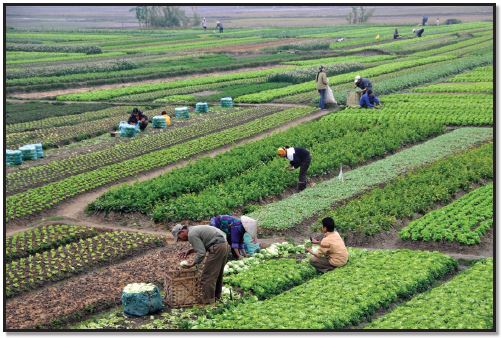A Comprehensive Overview to Commercial Farming vs Subsistence Farming Practices
A Comprehensive Overview to Commercial Farming vs Subsistence Farming Practices
Blog Article
Exploring the Differences In Between Commercial Farming and Subsistence Farming Practices
The duality in between commercial and subsistence farming practices is noted by varying goals, operational scales, and resource utilization, each with profound effects for both the setting and culture. Conversely, subsistence farming emphasizes self-sufficiency, leveraging conventional techniques to sustain home requirements while nurturing area bonds and social heritage.
Economic Objectives
Financial purposes in farming techniques frequently dictate the techniques and range of procedures. In business farming, the key financial objective is to make best use of profit.
In contrast, subsistence farming is primarily oriented towards satisfying the instant requirements of the farmer's household, with excess manufacturing being marginal. The financial purpose below is usually not make money maximization, but rather self-sufficiency and danger reduction. These farmers commonly operate with limited resources and rely on standard farming methods, customized to local environmental conditions. The primary goal is to make sure food security for the home, with any type of excess fruit and vegetables marketed locally to cover standard needs. While business farming is profit-driven, subsistence farming is centered around sustainability and durability, reflecting a fundamentally different collection of financial imperatives.

Range of Operations
The difference between business and subsistence farming ends up being specifically apparent when taking into consideration the scale of operations. The scale of business farming allows for economic situations of range, resulting in decreased expenses per device through mass production, boosted efficiency, and the capability to spend in technological innovations.
In raw comparison, subsistence farming is normally small-scale, focusing on producing simply sufficient food to fulfill the instant requirements of the farmer's family or local area. The land location included in subsistence farming is typically restricted, with less access to modern-day innovation or automation.
Source Application
Source use in farming methods reveals significant distinctions in between industrial and subsistence methods. Commercial farming, identified by massive operations, usually uses innovative innovations and mechanization to maximize the usage of resources such as land, water, and fertilizers. These practices enable boosted efficiency and higher performance. The emphasis is on optimizing outcomes by leveraging economic climates of scale and releasing resources purposefully to make sure consistent supply and productivity. Precision agriculture is significantly embraced in commercial farming, making use of data analytics and satellite modern technology to keep an eye on plant health and wellness and optimize source application, further boosting yield and resource performance.
In contrast, subsistence farming operates on a much smaller sized scale, largely to click here to read fulfill the instant demands of the farmer's house. Resource use in subsistence farming is usually restricted by economic restrictions and a reliance on standard methods.
Environmental Influence

On the other hand, subsistence farming, exercised on a smaller sized range, typically utilizes standard strategies that are a lot more in consistency with the surrounding setting. While subsistence farming commonly has a lower environmental footprint, it is not without challenges.
Social and Cultural Ramifications
Farming methods are deeply intertwined with check my source the cultural and social fabric of communities, influencing and mirroring their worths, practices, and financial frameworks. In subsistence farming, the emphasis is on cultivating sufficient food to satisfy the prompt demands of the farmer's family members, usually cultivating a strong sense of area and shared duty. Such techniques are deeply rooted in regional customs, with understanding passed down with generations, thus preserving social heritage and strengthening communal connections.
On the other hand, commercial farming is largely driven by market needs and profitability, often causing a change towards monocultures and large operations. This approach can cause the erosion of traditional farming techniques and cultural identities, as local customizeds and knowledge are replaced by standardized, commercial techniques. The emphasis on efficiency and earnings can in some cases lessen the social cohesion located in subsistence communities, as financial transactions change community-based exchanges.
The dichotomy in between these farming practices highlights the more comprehensive social implications of farming choices. While subsistence farming supports social continuity and neighborhood connection, commercial farming lines up with globalization and financial development, typically at the cost of standard social structures and multiculturalism. commercial farming vs subsistence farming. Stabilizing these aspects stays a critical difficulty for lasting farming growth
Conclusion
The evaluation of business and subsistence farming practices reveals considerable distinctions in purposes, range, source use, environmental effect, and social effects. Industrial farming focuses on earnings and performance through large-scale operations and advanced innovations, usually at the price of environmental sustainability. Conversely, subsistence farming emphasizes self-sufficiency, using conventional techniques and regional sources, therefore advertising social conservation and area communication. These contrasting approaches underscore the complicated interplay between economic growth and the requirement for ecologically lasting and socially inclusive farming techniques.
The dichotomy between commercial and subsistence farming methods is marked by varying goals, operational ranges, and source use, each with profound my response effects for both the setting and culture. While commercial farming is profit-driven, subsistence farming is focused around sustainability and durability, reflecting a basically various set of financial imperatives.
The distinction in between industrial and subsistence farming becomes specifically obvious when taking into consideration the scale of operations. While subsistence farming sustains cultural connection and community connection, business farming lines up with globalization and economic growth, often at the expense of traditional social frameworks and cultural variety.The evaluation of business and subsistence farming techniques reveals substantial differences in goals, range, resource use, ecological impact, and social ramifications.
Report this page